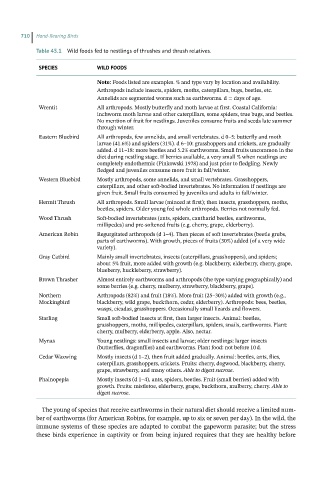Page 708 - Hand rearing birds second
P. 708
710 Hand-Rearing Birds
Table 45.1 Wild foods fed to nestlings of thrushes and thrush relatives.
SPECIES WILD FOODS
Note: Foods listed are examples. % and type vary by location and availability.
Arthropods include insects, spiders, moths, caterpillars, bugs, beetles, etc.
Annelids are segmented worms such as earthworms. d = days of age.
Wrentit All arthropods. Mostly butterfly and moth larvae at first. Coastal California:
inchworm moth larvae and other caterpillars, some spiders, true bugs, and beetles.
No mention of fruit for nestlings. Juveniles consume fruits and seeds late summer
through winter.
Eastern Bluebird All arthropods, few annelids, and small vertebrates. d 0–5: butterfly and moth
larvae (41.6%) and spiders (31%). d 6–10: grasshoppers and crickets, are gradually
added. d 11–18: more beetles and 5.2% earthworms. Small fruits uncommon in the
diet during nestling stage. If berries available, a very small % when nestlings are
completely endothermic (Pinkowski 1978) and just prior to fledgling. Newly
fledged and juveniles consume more fruit in fall/winter.
Western Bluebird Mostly arthropods, some annelids, and small vertebrates. Grasshoppers,
caterpillars, and other soft‐bodied invertebrates. No information if nestlings are
given fruit. Small fruits consumed by juveniles and adults in fall/winter.
Hermit Thrush All arthropods. Small larvae (minced at first); then insects, grasshoppers, moths,
beetles, spiders. Older young fed whole arthropods. Berries not normally fed.
Wood Thrush Soft‐bodied invertebrates (ants, spiders, cantharid beetles, earthworms,
millipedes) and pre‐softened fruits (e.g. cherry, grape, elderberry).
American Robin Regurgitated arthropods (d 1–4). Then pieces of soft invertebrates (beetle grubs,
parts of earthworms). With growth, pieces of fruits (30%) added (of a very wide
variety).
Gray Catbird Mainly small invertebrates, insects (caterpillars, grasshoppers), and spiders;
about 5% fruit, more added with growth (e.g. blackberry, elderberry, cherry, grape,
blueberry, huckleberry, strawberry).
Brown Thrasher Almost entirely earthworms and arthropods (the type varying geographically) and
some berries (e.g. cherry, mulberry, strawberry, blackberry, grape).
Northern Arthropods (82%) and fruit (18%). More fruit (25–30%) added with growth (e.g.,
Mockingbird blackberry, wild grape, buckthorn, cedar, elderberry). Arthropods: bees, beetles,
wasps, cicadas, grasshoppers. Occasionally small lizards and flowers.
Starling Small soft‐bodied insects at first, then larger insects. Animal: beetles,
grasshoppers, moths, millipedes, caterpillars, spiders, snails, earthworms. Plant:
cherry, mulberry, elderberry, apple. Also, nectar.
Mynas Young nestlings: small insects and larvae; older nestlings: larger insects
(butterflies, dragonflies) and earthworms. Plant food: not before 10 d.
Cedar Waxwing Mostly insects (d 1–2), then fruit added gradually. Animal: beetles, ants, flies,
caterpillars, grasshoppers, crickets. Fruits: cherry, dogwood, blackberry, cherry,
grape, strawberry, and many others. Able to digest sucrose.
Phainopepla Mostly insects (d 1–4), ants, spiders, beetles. Fruit (small berries) added with
growth. Fruits: mistletoe, elderberry, grape, buckthorn, mulberry, cherry. Able to
digest sucrose.
The young of species that receive earthworms in their natural diet should receive a limited num-
ber of earthworms (for American Robins, for example, up to six or seven per day). In the wild, the
immune systems of these species are adapted to combat the gapeworm parasite; but the stress
these birds experience in captivity or from being injured requires that they are healthy before

